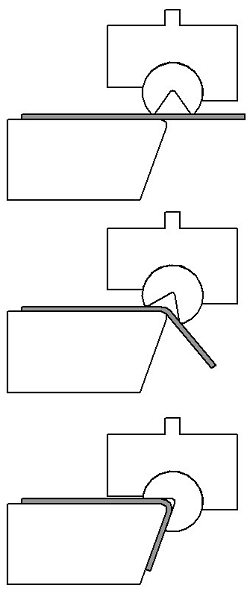 A rotary die is a special type of punch die combination which bends the sheet metal using a rotating cylinder with a v opening cut into the side of the cylinder. The cylinder is seated into a saddle making up the punch section of the die. The sheet metal lays on an anvil and the rotary die is pushed down on top of it. As the die engages the sheet it begins to rotate and bends the metal around the tip of the anvil. Sometimes a backing plate (not shown) called a heel keeps the saddle steady as the machine is closed and the bend completed.
A rotary die is a special type of punch die combination which bends the sheet metal using a rotating cylinder with a v opening cut into the side of the cylinder. The cylinder is seated into a saddle making up the punch section of the die. The sheet metal lays on an anvil and the rotary die is pushed down on top of it. As the die engages the sheet it begins to rotate and bends the metal around the tip of the anvil. Sometimes a backing plate (not shown) called a heel keeps the saddle steady as the machine is closed and the bend completed.
Rotary dies provide a number of benefits over traditional punch die combination. The rotary die will clamp the sheet metal before bending providing a secure work piece without any sliding. As the sheet is bent the worker side does not move providing a safer and more ergonomic experience for the operator. The fact that the sheet does not move also means the the operator does not have to ‘chase’ the metal while it’s being bent, improving the quality of the bend. Rotary dies can also bend beyond 90 ° like traditional tooling to compensate for Spring Back. Many operations can have their required tonnage reduced by using a rotor die. Rotary dies also allow for the creation of complicated setups which can quickly and accurately bend standardized profiles. This can be beneficial for production type environments because it takes less effort to create a consistent part.
Draw backs to rotary bending include price and geometry limitation. Because of their mechanical nature rotary dies can be comparatively expensive, making them better suited for production type environments. Their geometry will typically only allow the profile that they are designed for to be bent, however clever design can allow bends which would be difficult or impossible with traditional dies.
Because of their advantages for standard production rotary dies are often used in stamping operations in combination with other geometries rather than on a press brake.